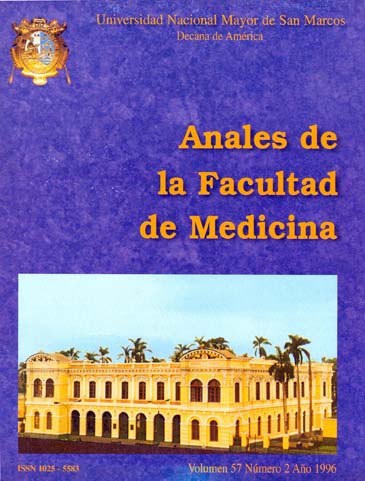Quetelet Index in Child Nutritional Diagnosis
DOI:
https://doi.org/10.15381/anales.v57i2.4844Keywords:
Nutritional status, Quetelet Index, Children, National levelAbstract
A total of 1547 children of both sexes and between 6 and 9 years of age were studied. This sample is representative at national level and belongs to the data source of the Survey of Nutritional Status of the Peruvian Habitant ("Evaluacion del Estado Nutritional del Poblador Peruano" , ENPPE 1975) which was executed by the Institute of Nutrition . Anthropometric measures taken were weight and height. The children's nutritional status was analyzed using the Quetelet Index (w/h2), taking as break point level 5 and 15p for deficit and low weight, and 85 and 95p for overweight and excess, respectively. The standard reference used is the one described by Must et al. Weight and height average were also analyzed. There exists a higher prevalence of overweight (13.9%) than excess weight (4.4%). Low weight (3.6%) and deficit (0.8%) prevalence is lower. Children grow within the curve which corresponds to -1.5 an -2 SD. Weights are between -0.5 and -1 SD. As to the geoecologic domains, girls level of growth in the high jungle and north highland and boys growth in the north highland and low jungle are below -2 SD. In conclusion, the Quetelet Index gives a higher tendency to overweight and excess weighh that reflects the behaviour of weight and height by separate.Downloads
Published
1996-06-17
Issue
Section
Trabajos originales
License
Copyright (c) 1996 Jaime Pajuelo, Isabel Amemiya

This work is licensed under a Creative Commons Attribution-NonCommercial-ShareAlike 4.0 International License.
Those authors who have publications with this magazine accept the following terms:
- Authors will retain their copyrights and guarantee the journal the right of first publication of their work, which will be simultaneously subject to Creative Commons Attribution License that allows third parties to share the work as long as its author and its first publication this magazine are indicated.
- Authors may adopt other non-exclusive licensing agreements for the distribution of the version of the published work (eg, deposit it in an institutional electronic file or publish it in a monographic volume) provided that the initial publication in this magazine is indicated.
- Authors are allowed and recommended to disseminate their work over the Internet (eg: in institutional telematic archives or on their website) before and during the submission process, which It can produce interesting exchanges and increase quotes from the published work. (See El efecto del acceso abierto ).
How to Cite
1.
Pajuelo J, Amemiya I. Quetelet Index in Child Nutritional Diagnosis. An Fac med [Internet]. 1996 Jun. 17 [cited 2025 Jun. 1];57(2):103-8. Available from: https://revistasinvestigacion.unmsm.edu.pe/index.php/anales/article/view/4844



